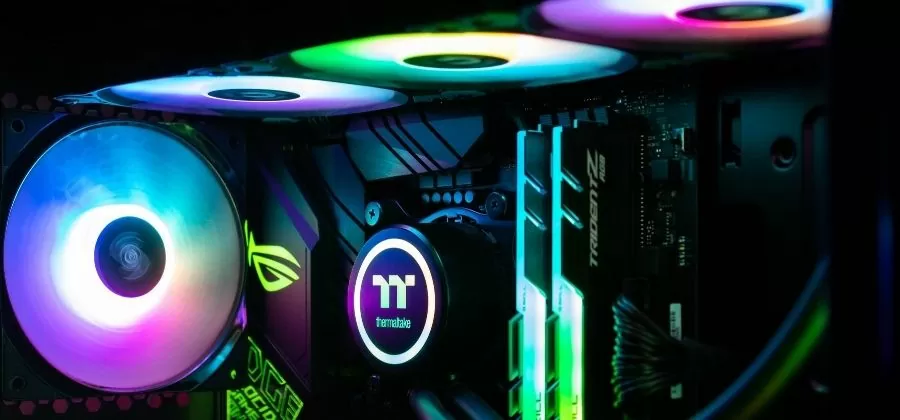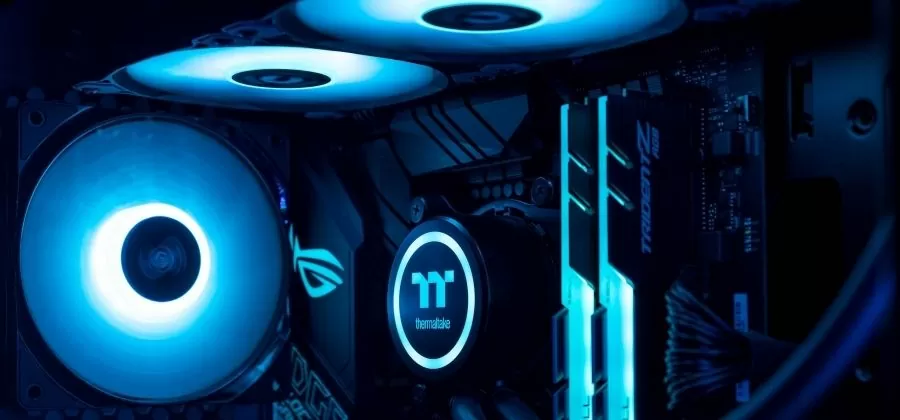The RGB lighting is a pretty sweet thing to have, especially if you’re into modding your gaming PC. Unfortunately, it can be a bit difficult to connect the fans that look so great with this kind of lighting. Luckily, we have a few quick and easy solutions for this issue!
It is possible to connect RGB fans to motherboards in many different ways. There are 5 types of RGB fans for you to choose, that is RGB fans with the controller, motherboard RGB 4 pin, motherboard RGB 3 pin, RGB Fan to RGB Fan, and RGB Fan to RGB Strip. You can choose different fans and strips according to your needs. You can also follow this blog and use the correct way to connect RGB fans to your motherboard. So, here it is…
How to connect RGB fans to motherboard – 3 simple methods

In this blog post we’ll go over three simple methods for connecting RGB fans to the motherboard: using an adapter cable, splicing the cables together, or using a hub. Let’s get started!
Method One: Using an Adapter Cable
This is probably the easiest way to connect your RGB fans to your motherboard. The only thing you need is an adapter cable and some time. It works like this:
- Plug the adapter cable into your RGB fan and the other end into your motherboard’s RGB header.
- Connect your fans to the adapter cable using the provided connector.
- Power on your computer and enjoy the RGB fans!
That’s all there is to it! Using an adapter cable is a great way to quickly and easily add some flashy RGB lighting to your PC. How To Add More SATA Ports To A Motherboard?
Method Two: Splicing the Cables Together
If you don’t have an adapter cable or you want to save a few bucks, you can always splice the cables together. Using this method is a little more complicated than using an adapter cable, but it’s still pretty straightforward. To do so, follow these steps:
- Cut the connector off of one of the RGB fan cables.
- Strip the insulation away from the end of the cable and twist the wires together.
- Wrap the wires in heat shrink tubing or electrical tape after soldering them together.
- Repeat steps 2-3 for the other fan cable.
- Plug your fans into the spliced cables and connect to your motherboard.
- Switch on your RGB fans and enjoy!
Although this method takes a little longer, it can save you a few dollars. Plus, it gives you a little more flexibility when connecting with your fans.
Method Three: Using a Hub
If you want the simplest and most hassle-free way to connect your RGB fans to your motherboard, then using a hub is the way to go. Let me explain:
- Connect the RGB fan cables to the hub.
- Connect the hub to your motherboard’s RGB header.
- Enjoy your new RGB fans!
That’s all there is to it! Using a hub is an easy way to connect all of your fans without any fuss or muss. So, which method is right for you?
Basically, it’s all a matter of budget and what’s available. If you have an extra adapter cable or hub laying around, then that’s probably the easiest way to connect your RGB fans. Or, if you don’t want to spend any money, simply splice the cables together! Whichever method you choose is up to you, but all three are quick and easy ways of connecting your RGB fans to the motherboard. How To Fix Motherboard Error 99? [Guide For Beginners]
Where to plug in RGB fans on the motherboard?
Now that you know how to connect your RGB fans to the motherboard, the next question is: where do you plug them in? Depending on your motherboard, there are a few different places where you can plug in your fans. Here are the most common locations:
- RGB Header: This is the most common location for connecting RGB fans to the motherboard. The RGB header is usually a 4-pin connector and is located close to the CPU.
- HD Audio Header: This is another common location for connecting RGB fans to the motherboard. The HD Audio header is usually a 6-pin connector and is located near the SATA connectors.
- Other headers: Some motherboards have additional RGB headers, usually located near the CPU. You can add RGB lighting to your PC using this option.
- SATA connectors: On some motherboards, you can connect RGB fans directly to the SATA power connector using an optional cable. Depending on your motherboard, this may be a 6-pin or 8-pin connector and is usually located near the CPU.
- Jumper pins: Some motherboards have jumper pins for connecting RGB fans. This is not a common location, but it’s an option if your motherboard has them.
So, which header should you use? It really just depends on your motherboard and what type of connector it has. The best way to find out is to reference your motherboard’s manual and look for an RGB header. As you can see, there are multiple places on the motherboard where RGB fans can be plugged in. Generally speaking, the easy options (adapter cables or hubs) will be the best choice if those connectors exist on your motherboard. If not, Splicing the Cables Together or Using a Hub are your next best options.
How to connect multiple RGB fans to the motherboard?

Pretty easy. Here’s how it works:
- Cut the connector off of one of the RGB fan cables.
- Strip the insulation away from the end of the cable and twist the wires together.
- Wrap the wires in heat shrink tubing or electrical tape after soldering them together.
- Repeat steps 2-3 for the other cable.
- Plug each of the connector-less RGB fan cables into the motherboard’s RGB header.
- Turn on your PC and enjoy your new RGB fans!
How to connect cooler master RGB fans to the motherboard?
Cooler Master has their own RGB controller that you can use to connect its RGB fans to your motherboard. To use it, follow these steps:
- Insert the RGB fan cables into the controller.
- Connect the controller to your motherboard’s RGB header.
- Turn on your PC and enjoy your new RGB fans!
That’s actually it! It’s so easy! The only downside is that the Cooler Master RGB controller supports a maximum of two fans. So, if you want to connect more than two Cooler Master RGB fans you’ll have to use a different method.
How to connect Corsair RGB fans to the motherboard?
The Corsair Lighting Node Pro has a built-in 4-pin RGB header. So, if your motherboard has a free 4-pin RGB header you can simply connect the Lighting Node Pro to it and then plug your Corsair RGB fans into the Lighting Node Pro.
- Plug the fan connector into the Lighting Node Pro’s main port (labeled “SYNC”).
- Plug the RGB LED connector into the Lighting Node Pro’s AUX port (labeled “RGB”).
- Connect the Lighting Node Pro to your motherboard’s RGB header.
- Turn on your PC and enjoy your new Corsair RGB fans!
If you have more than three Corsair RGB fans, you can use a Y-splitter to connect them all to the Lighting Node Pro.
How to connect RGB fans to the power supply?
There are a few ways to connect RGB fans to the power supply.
RGB fan header: Some power supplies have a special RGB fan header that allows you to connect RGB fans directly to the power supply.
3-pin or 4-pin Molex connector: If your power supply doesn’t have a dedicated RGB fan header, you can still connect RGB fans to the power supply by using a 3-pin or 4-pin Molex connector.
USB connector: Some RGB fans come with a USB connector that allows you to connect the fan to a USB port on your computer. If your power supply doesn’t have a dedicated RGB fan header or a 3-pin or 4-pin Molex connector, you can still connect the RGB fan to your computer by using a USB connector.
RGB splitter: If your power supply doesn’t have an RGB fan header and it doesn’t have 3-pin or 4-pin Molex connectors, use the RGB splitter that came with your RGB fans.
Frequently Asked Questions
How to connect RGB fans to the gigabyte motherboard?
Connecting RGB fans to a motherboard (especially Gigabyte) can be a pain sometimes. These RGB fans come with a 4-pin power connector which is not really compatible with most motherboards. Luckily, this adapter can be used to convert the 4-pin connector to 3-pin.
Conclusion:
This blog post has covered the three best ways how to connect RGB fans to motherboard. If you want to add some flashy RGB lighting while saving a few bucks, you should definitely put the cables together with a shot. It’s quick and easy and requires no special tools or skills.
Alternatively, if you already have an extra adapter cable or hub lying around it’s even easier! Simply follow the instructions associated with that particular method and get your RGB on! Thank you for taking the time to read this article. I hope you found it useful. Good luck! Have any questions? Ask in the comments section below.

![How To Fix A CPU Cooler Not Lighting Up? [New Guide 2023]](https://www.drtechreviews.com/wp-content/uploads/2022/07/How-To-Fix-A-CPU-Cooler-Not-Lighting-Up-450x210.jpg)

![Why Is My CPU Cooler So Loud? [Facts 2023]](https://www.drtechreviews.com/wp-content/uploads/2022/07/Why-Is-My-CPU-Cooler-So-Loud-450x210.jpg)
![Fix Dual Monitor Lag In Windows [Explanation For Beginners]](https://www.drtechreviews.com/wp-content/uploads/2022/07/Fix-Dual-Monitor-Lag-In-Windows-450x210.jpg)
![Fix A Monitor Randomly Loses Signal [Problems & Solutions 2023]](https://www.drtechreviews.com/wp-content/uploads/2022/07/Fix-A-Monitor-Randomly-Loses-Signal-450x210.jpg)